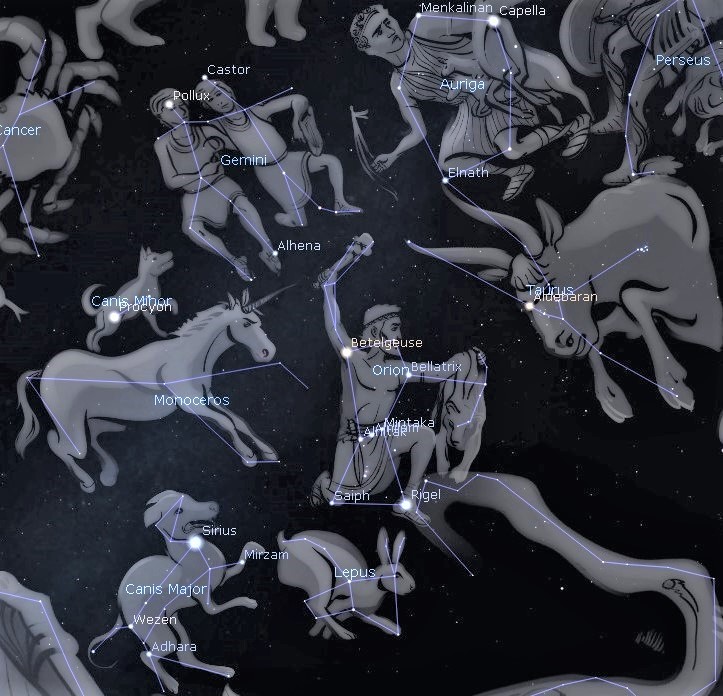This Week’s Sky at a Glance, 2021 December 25 – 2022 January 1 ~by Curt Nason
Before, or after, the flash of New Year’s Eve fireworks this week, take a look around the sky. As a new year begins, many of the brightest stars are at their best when you face south. Halfway up the sky is the slanted line of three stars that forms Orion’s Belt. Above it are the shoulders of the giant hunter, marked by reddish-orange Betelgeuse and Bellatrix. Below, blue-white Rigel and Saiph are parts of Orion’s legs. The Belt points to the right at the V-shaped Hyades star cluster, anchored by orange Aldebaran, and the compact, eye-catching Pleiades cluster, which together form the face and shoulder of Taurus the Bull.
To the left of the Belt is the night sky’s brightest star, Sirius, in Canis Major, the larger of Orion’s two canine companions. Bellatrix and dim Meissa, marking Orion’s head, form an arrowhead with Betelgeuse at the tip, which points toward Procyon in two-star Canis Minor. Auriga and Gemini ride above Orion. Among these New Year’s Eve constellations are five of the ten brightest stars, with 12 more in the top 50. Betelgeuse, like many red supergiant stars, varies in brightness over long periods as it expands and contracts.
Rather than make a New Year’s resolution that involves great sacrifice and likely won’t see February, why not start an astronomy project to learn the sky over the year. I recommend the RASC Explore the Universe program, which involves observing and describing or sketching objects using your unaided eyes, binoculars or a small telescope. The objects include constellations and bright stars, lunar features, the solar system, deep sky, and double stars. By observing 55 of the 110 objects you could earn a certificate and a pin. For details, see RASC Explore the Universe or contact me.
This Week in the Solar System
Saturday’s sunrise in Moncton is at 8:00 am and sunset will occur at 4:38 pm, giving 8 hours, 38 minutes of daylight (8:02 am and 4:46 pm in Saint John). Next Saturday the Sun will rise at 8:01 am and set at 4:44 pm, giving 8 hours, 43 minutes of daylight (8:03 am and 4:52 pm in Saint John).
The Moon is at third quarter on Sunday and it passes near Mars on Friday. Mercury is a binocular width below Venus on Tuesday and sits well to the left of it on Friday. Saturn and Jupiter are still well placed for observing in early evening, and on Wednesday telescope users might catch the shadow of Jupiter’s largest moon Ganymede in transit until 6:48 pm. Over the week Mars slides down to the left of its currently brighter namesake, the orange supergiant star Antares – “the rival of Mars.”
Questions? Contact Curt Nason.

